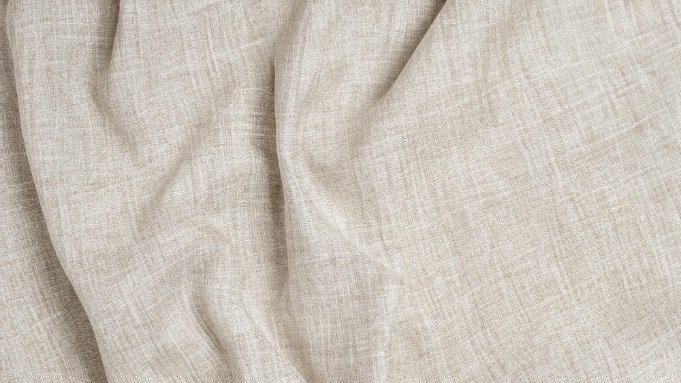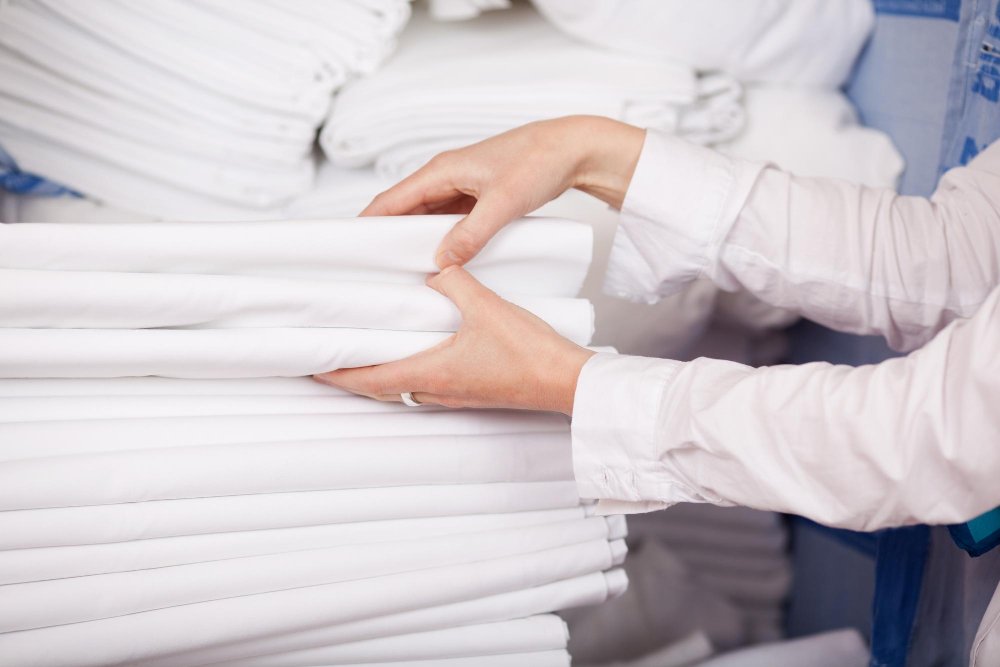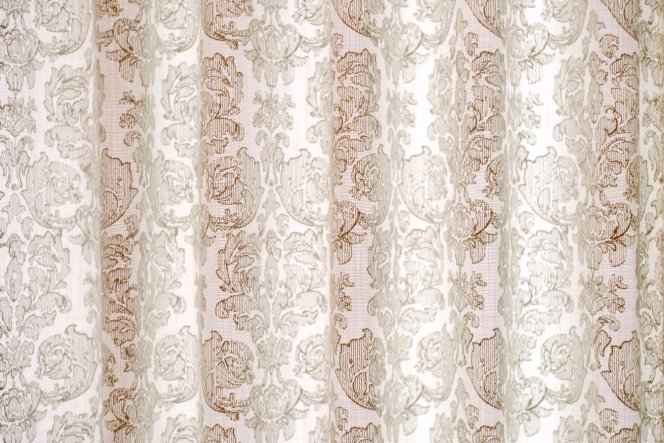Everything you need to know about linen fabric, from its ancient origins to modern applications
Table of Contents
- What is Linen Fabric?
- History and Ancient Origins
- How Linen is Made
- Types of Linen Fabric
- Properties and Characteristics
- Linen vs Cotton
- How to Identify Quality Linen
- What is Linen Used For?
- Sustainability and Environmental Impact
- How to Wash and Care for Linen
- Why is Linen So Expensive?
- Frequently Asked Questions
What is Linen Fabric?
Linen is a natural textile made from the fibers of the flax plant (Linum usitatissimum). It’s one of the oldest fabrics known to humanity, with evidence of linen production dating back over 30,000 years. Unlike cotton, which comes from the fluffy bolls around cotton seeds, linen comes from the long, strong fibers inside flax plant stems.
The word “linen” itself comes from the Latin name for flax, and it’s even related to the word “line” because the fabric threads are woven in straight lines. This natural fiber has been treasured throughout history for its unique combination of strength, breathability, and elegant drape.
Quick Facts About Linen
Linen fibers are incredibly strong, actually becoming about 10% stronger when wet. This natural fabric is 30% stronger than cotton and can last for decades with proper care.
What Type of Fabric is Linen?
Linen is classified as a natural bast fiber fabric. Bast fibers are the fibrous material that grows in the inner bark (or bast) of certain plants. This puts linen in the same category as hemp and ramie. It’s completely natural, biodegradable, and plant-based, making it very different from synthetic fabrics like polyester.
The fabric typically has a plain weave, which means the warp and weft threads go over and under each other in a simple pattern. This classic weave gives linen its characteristic smooth yet slightly textured surface with a natural luster that becomes more beautiful with age.
The Ancient History of Linen
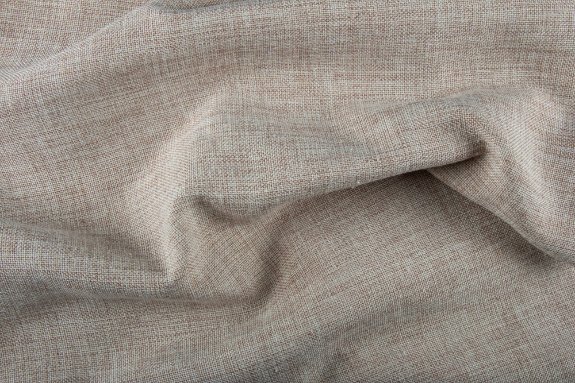
Linen has an amazing history that spans thousands of years. Archaeological evidence shows that prehistoric peoples were making garments from wild flax fibers as far back as 30,000 years ago. That makes linen one of the first textiles ever created by humans.
Ancient Egyptians were the first civilization to produce linen on a large scale. They considered linen a symbol of purity and light, using it for everything from everyday clothing to wrapping mummies. In fact, linen fabric has been found intact in Egyptian tombs today, a testament to its incredible durability. The fabric was so valuable that wealthy Egyptians used it as currency for trade.
Throughout history, linen has been mentioned in religious texts and used by cultures worldwide. The Greeks and Romans valued it for keeping them cool in warm weather. During the Middle Ages, linen production became a major industry in Europe. Until the mid-19th century, most farmers in northern America grew flax to clothe their families.
How Linen is Made: From Flax to Fabric
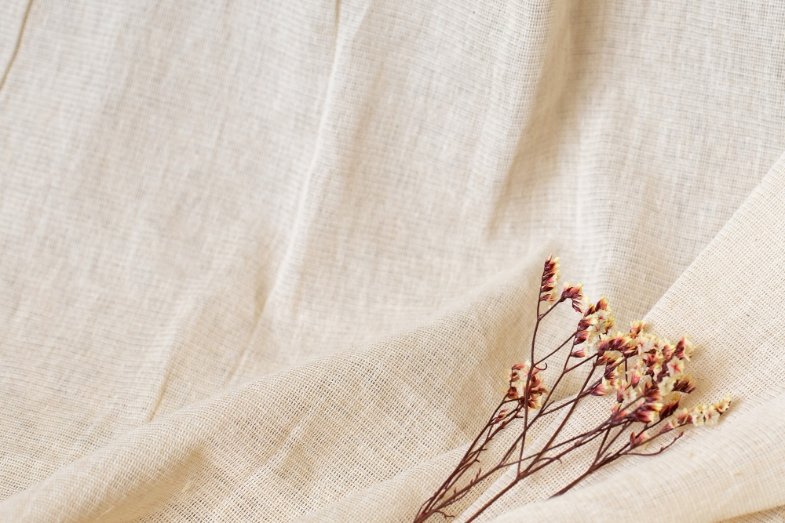
The process of turning flax plants into linen fabric is long and requires skill, which is one reason why linen tends to be more expensive than other fabrics. According to research from the US Department of Agriculture, the production process has remained largely unchanged for centuries, combining traditional methods with modern efficiency. Here’s how it works:
The Linen Production Process
Growing Flax
Flax plants need about 100 days to grow. They thrive in cool, cloudy weather and are typically grown in areas with these conditions. The best linen comes from France and Belgium, though flax is also grown in China, Canada, Italy, and Tunisia.
Harvesting
When the seed heads turn golden and the plants reach maturity, they’re ready for harvest. The plants are pulled from the ground (not cut) to keep the long fibers intact.
Retting
The harvested plants are left in fields to decompose slightly. This process, called retting, helps separate the usable fibers from the woody parts of the stem. It can take several weeks.
Scutching and Breaking
The retted flax goes through mechanical processes that break down the woody outer layers and separate the bast fibers from the inner pith.
Heckling (Combing)
The fibers are combed to separate long fibers from short ones and remove any remaining impurities. Long fibers produce the finest linen.
Spinning
The fibers are twisted together to create yarn. Long fibers can be spun wet for smooth, fine linen, while shorter fibers are twisted dry for a sturdier, more textured version used in upholstery.
Weaving
Finally, the linen yarn is woven into fabric. European weaving mills, especially those in Italy, are known for producing the highest quality linen fabrics.
What are the Four Types of Linen?
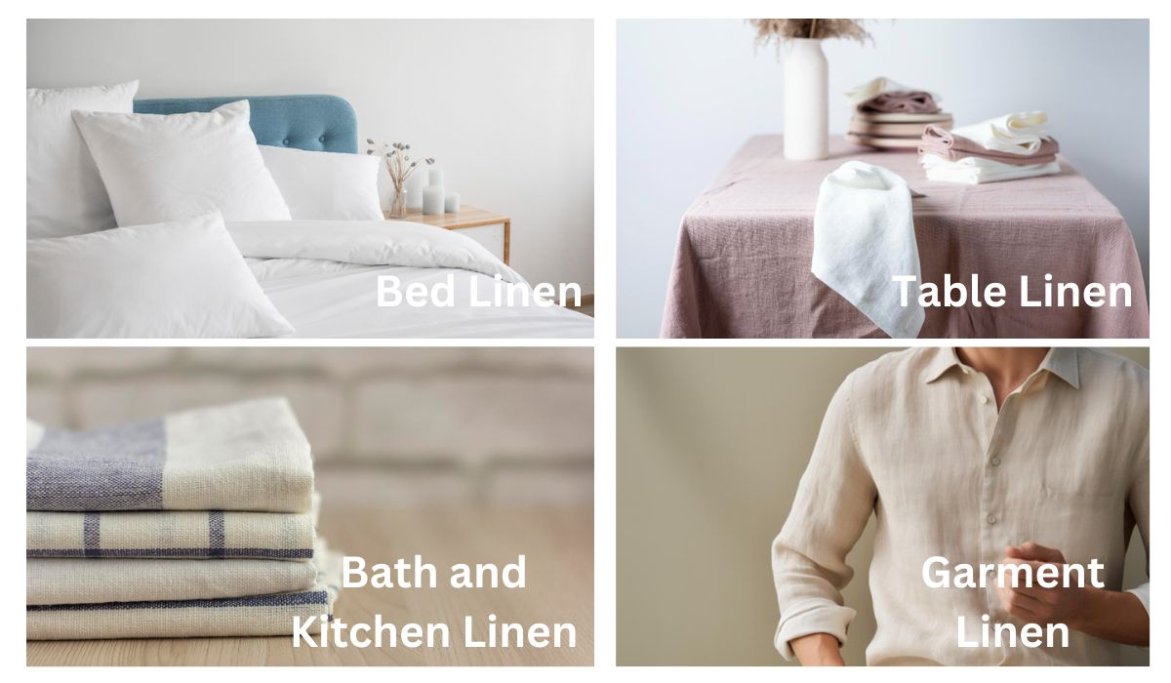
When people ask about the “four types” of linen, they’re usually referring to either the functional categories or the weave types. Let’s look at both:
Four Functional Categories of Linen
1. Bed Linen
Sheets, pillowcases, and duvet covers. This includes sheeting linen, which is tightly woven and durable.
2. Table Linen
Tablecloths, napkins, placemats, and runners. Often features damask or embroidered designs.
3. Bath and Kitchen Linen
Towels, dish cloths, and tea towels. These take advantage of linen’s high absorbency.
4. Garment Linen
Clothing fabrics including dress linen, shirting linen, and suit linen. Ranges from lightweight to heavy depending on use.
Common Types by Weave and Weight
Choosing the right linen weight is important for your project’s success. Here’s a breakdown of the most common types:
| Type | Weight (GSM) | Best Uses | Characteristics |
|---|---|---|---|
| Plain Weave Linen | 140-200 | Shirts, dresses, table linens | Most common type, simple over-under pattern, crisp and durable |
| Damask Linen | 180-250 | Formal table settings, decorative items | Reversible patterns woven into fabric, luxurious appearance |
| Loose Weave Linen | 100-150 | Tea towels, summer clothing, curtains | More relaxed structure, highly absorbent, lighter weight |
| Sheeting Linen | 180-220 | Bed sheets, pillowcases | Tightly woven for durability and comfort |
| Belgian Linen | 280-420 | Upholstery, heavy bedding | Heavy-weight, very durable, available in many colors |
| Irish Linen | 170-190 | Fine table linens, handkerchiefs | Known for exceptional quality, lightweight but strong |
| European Linen | 240-280 | Clothing, upholstery | Medium-weight, balances structure with drape |
Understanding Linen Weights
Linen weight is measured in grams per square meter (GSM). Here’s a visual guide:
Perfect for summer clothing, scarves, and lightweight curtains
Ideal for bedding, table linens, and most garments
Best for upholstery, bags, and durable home textiles
Not sure which weight you need? Use our Linen Fabric Weight Calculator to find the perfect GSM for your project.
Linen Blends
Not all linen products are 100% pure linen. Many are blended with other fibers to change their properties:
Linen-Cotton Blend: Softer and easier to care for than pure linen. Less wrinkling and often more affordable.
Linen-Viscose/Rayon Blend: Adds drape and softness while maintaining some of linen’s breathability.
Linen-Silk Blend: Creates a luxurious fabric with a smooth, shiny finish. Often used for elegant garments.
Linen-Polyester Blend: Offers wrinkle resistance and durability at a lower price point, though it loses some breathability.
Need Help Choosing?
With so many types of linen available, it can be overwhelming to pick the right one. Take our Linen Type Selector Quiz to get personalized recommendations based on your specific needs and project requirements.
Five Characteristics of Linen Fabric
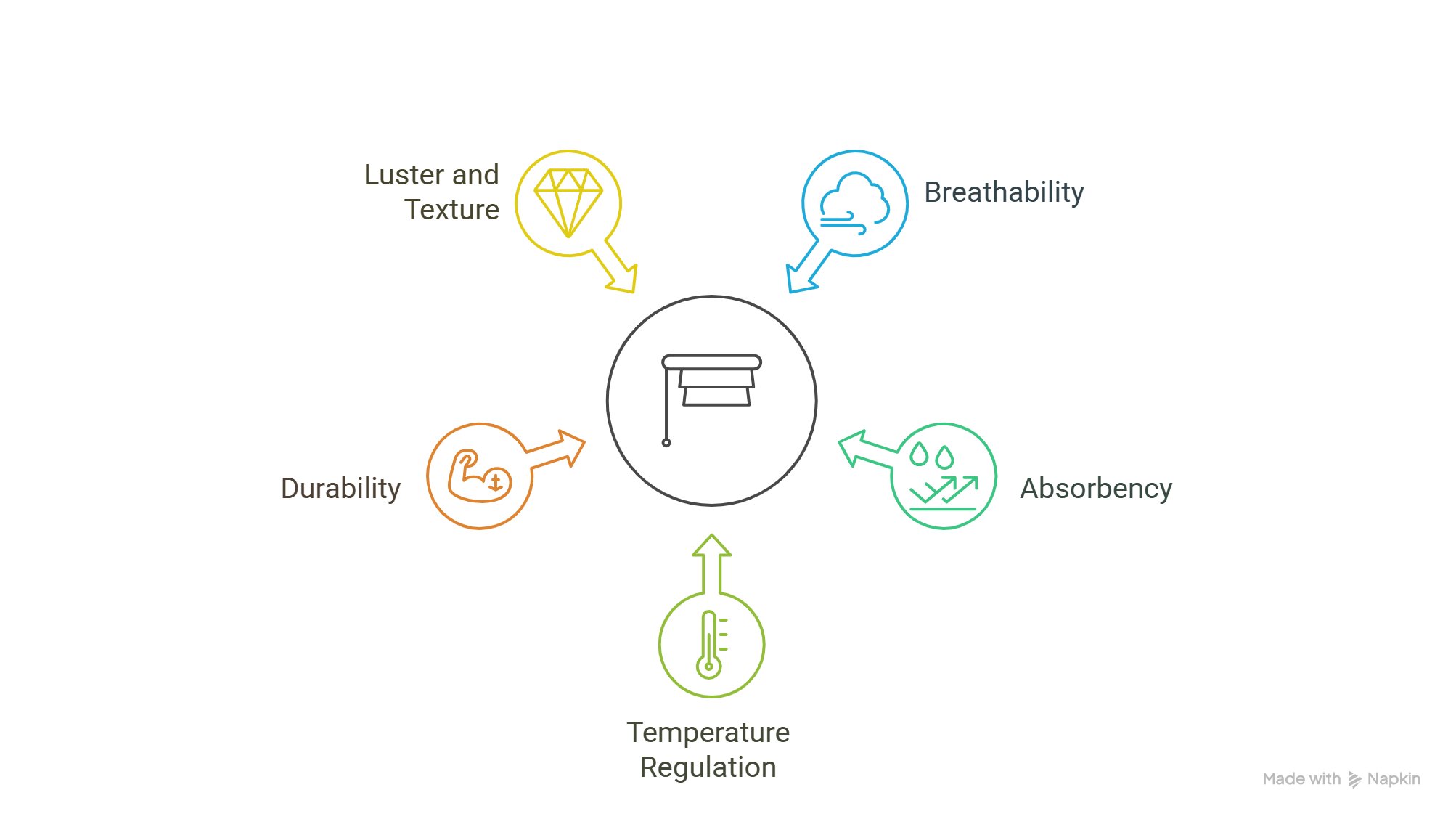
What makes linen special? Here are the key properties that set this natural fiber apart:
1. Exceptional Breathability
Linen’s loose weave allows air to circulate freely. The hollow fibers let heat escape, keeping you cool even on hot days. It’s one of the most breathable fabrics available.
2. High Absorbency
Linen can absorb up to 20% of its weight in moisture before feeling damp. It also dries quickly, making it perfect for towels and summer clothing.
3. Natural Temperature Regulation
In hot weather, linen stays cool and dry. In cold weather, it works as an insulator when layered. This makes linen suitable for year-round use.
4. Incredible Durability
Linen is one of the strongest natural fibers. It gets stronger when wet and doesn’t pill or deteriorate easily. Well-made linen items can last for generations.
5. Natural Luster and Texture
Linen has a subtle shine that comes from the fiber’s natural wax content. The slightly nubby texture gives it character and becomes softer with each wash.
Additional Properties Worth Knowing
Antibacterial and Hypoallergenic: Linen naturally resists bacteria, fungi, and dust mites. This makes it great for people with allergies or sensitive skin.
Anti-Static: Unlike synthetic fabrics, linen doesn’t cling to your body or generate static electricity.
Low Elasticity: Linen doesn’t stretch much, which means it holds its shape well but also wrinkles easily. The wrinkles are considered part of its natural charm.
Naturally Insect-Resistant: Pests like moths aren’t attracted to linen the way they are to wool.
What is the Main Disadvantage of Linen?
The biggest drawback of linen is that it wrinkles very easily. Because linen fibers lack elasticity, the fabric creases quickly and can look rumpled after just a short time of wear. While many people love the relaxed, lived-in look of wrinkled linen, others find it too casual or messy-looking for professional settings.
Other disadvantages include:
Higher cost: Linen is more expensive than cotton or synthetics due to the labor-intensive production process.
Potential shrinkage: Linen can shrink if washed in hot water or dried on high heat.
Initial stiffness: New linen can feel rough or scratchy until it’s been washed several times.
Color fading: Dyed linen can fade if left in direct sunlight for extended periods.
Is Linen Better Than Cotton?
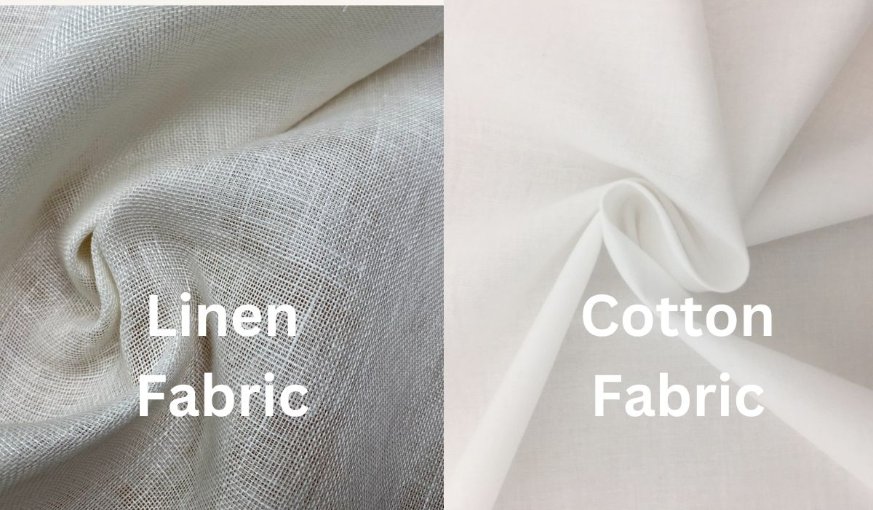
This is one of the most common questions, and the answer depends on what you’re looking for. Neither fabric is objectively “better” – they each have strengths for different situations.
| Feature | Linen | Cotton |
|---|---|---|
| Strength | 30% stronger than cotton, gets stronger when wet | Strong but not as durable as linen |
| Breathability | Highly breathable, excellent air flow | Breathable but less so than linen |
| Absorbency | Absorbs 20% of weight in moisture, dries quickly | Very absorbent but dries more slowly |
| Temperature | Stays cooler in hot weather | Warmer than linen in same conditions |
| Softness | Starts crisp, becomes softer with each wash | Soft from the start, stays consistent |
| Wrinkles | Wrinkles very easily | Wrinkles less, easier to iron |
| Cost | More expensive | Generally more affordable |
| Lifespan | Can last decades with proper care | Long-lasting but typically shorter than linen |
| Environmental Impact | Requires less water and pesticides | Requires more water and often pesticides |
| Shrinkage | Can shrink 3-5% if not pre-washed | Can shrink 2-5% in first wash |
Is Linen Cooler Than Cotton?
Yes, linen is cooler than cotton. The hollow structure of linen fibers allows better air circulation, and the fabric’s natural moisture-wicking properties help keep you dry. Studies show that linen fabric can lower skin temperature by several degrees compared to cotton in hot conditions.
Are 100% Cotton and Linen the Same?
No, they’re completely different materials. Cotton comes from the fluffy fibers around cotton plant seeds, while linen comes from the stem of the flax plant. They have different textures, properties, and production processes. However, both are natural, breathable fabrics that are popular for warm-weather clothing.
Is Linen Better Quality Than Cotton?
In terms of durability and longevity, yes – linen is generally considered higher quality. It’s stronger, lasts longer, and doesn’t deteriorate as quickly. However, “quality” can also mean comfort, and some people prefer the initial softness of cotton. High-quality versions of both fabrics exist. For example, Egyptian cotton is a premium cotton variety, just as Belgian linen is a premium linen type.
How to Identify Quality Linen
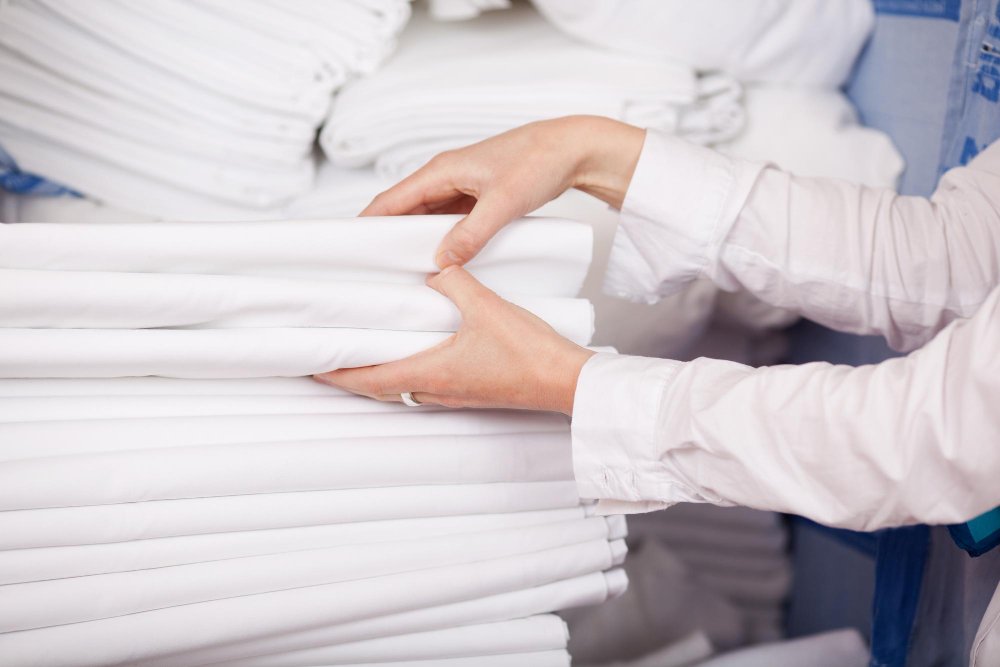
Not all linen is created equal. Here’s how to spot the good stuff:
Check the Weight
Quality linen has appropriate weight for its intended use. Pick it up and feel if it has substance. If you ordered medium-weight linen (140-190 GSM) but it feels thin and insubstantial, it might not be 100% linen or may be lower quality.
Look at the Color
Natural undyed linen comes in shades of ivory, oatmeal, taupe, ecru, and grey. The color depends on how the flax was processed. High-quality dyed linen should have even, smooth color without blotching or fading in spots.
Test the Wrinkles
Real linen wrinkles easily. Crumple a corner in your hand – if it springs back without creases, it’s likely a blend with synthetic fibers. Quality linen will show natural wrinkles that are part of its character.
Feel for Slubs
Slubs are small, natural irregularities or knots in the weave. They used to be considered defects but are now recognized as one of linen’s perfect imperfections. They’re a sign of authentic linen made from natural fibers.
Check Fiber Length
High-quality linen is made from long fibers, resulting in smoother, more durable fabric with a refined look. Short-fiber linen produces coarser fabric that’s less elegant but still usable for upholstery or utility items.
Test Moisture Absorption
Put a small drop of water on the fabric. Quality linen should absorb it quickly without the water beading up on the surface.
Check the Price
While price isn’t everything, very cheap “linen” is often a blend or low-quality fabric. Expect to pay $10-30 per yard for good quality linen fabric, with specialty or artisan linen costing even more.
Look for Quality Certifications
When buying linen, look for certifications like Masters of Linen (guarantees European production from flax to fabric) or OEKO-TEX Standard 100 (ensures the fabric has been tested for harmful substances). These certifications verify quality and ethical production standards.
Want to test your knowledge? Take our Linen Quality Quiz to learn how to spot high-quality linen like a pro and avoid common shopping mistakes.
What is Linen Best For?
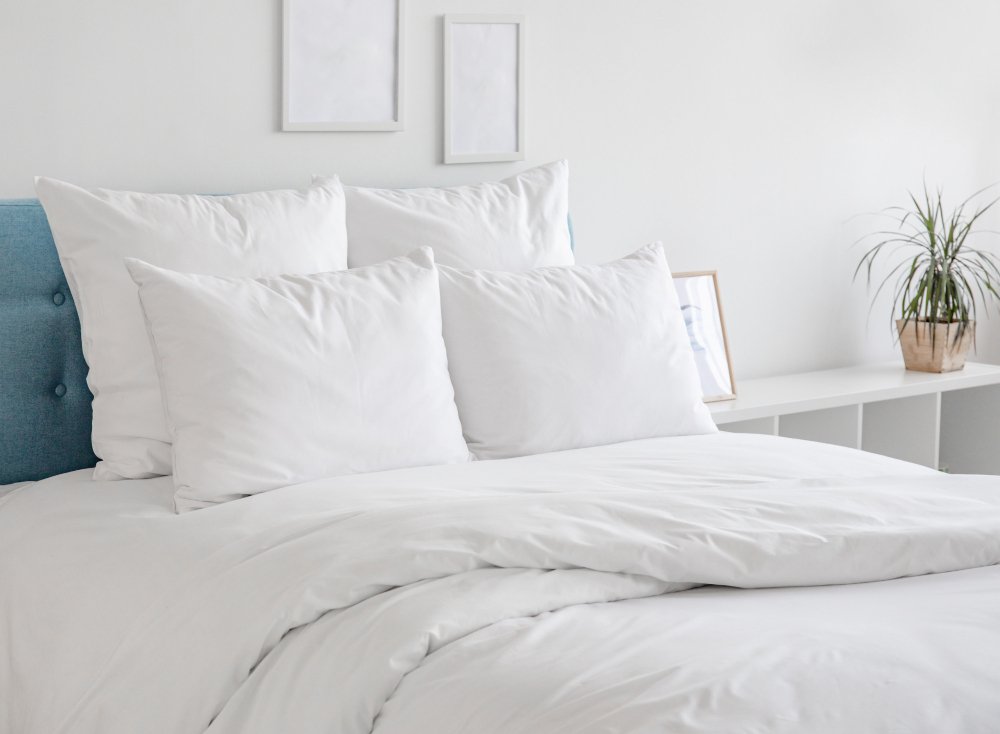
Linen’s unique properties make it suitable for many applications:
Clothing
Linen is perfect for warm-weather clothing. Summer dresses, shirts, pants, and suits made from linen keep you cool and comfortable. It’s also used for underwear due to its antibacterial properties. Linen clothing has become especially popular in 2025 fashion trends, with designers featuring everything from oversized linen shirts to flowing dresses and wide-leg pants.
Bedding
Linen sheets, pillowcases, and duvet covers are highly sought after. They regulate temperature well, keeping you cool in summer and warm in winter. Linen bedding gets softer and more comfortable with every wash, making it a great long-term investment.
Table Linens
Tablecloths, napkins, and placemats made from linen add elegance to dining. The fabric’s absorbency makes it practical, while its natural beauty makes it suitable for both everyday use and special occasions.
Towels and Kitchen Textiles
Linen dish towels, tea towels, and bath towels are highly absorbent and dry quickly. They’re naturally antibacterial, making them more hygienic than some other materials. They also don’t leave lint behind like cotton towels can.
Upholstery and Home Decor
Heavy-weight linen works beautifully for furniture upholstery, curtains, and decorative pillows. It’s durable enough to stand up to daily use while adding natural elegance to any room.
Medical and Healthcare
For thousands of years, linen has been used for bandages and surgical clothing. Its antibacterial and hypoallergenic properties make it naturally suited for medical applications. It can also be sterilized at high temperatures without damage.
Is Linen Good for Hot Weather?
Absolutely! Linen is one of the best fabrics for hot weather. Its breathability, moisture-wicking properties, and cooling effect make it the go-to choice for summer clothing in warm climates. Many tropical and Mediterranean regions have traditional clothing made from linen for exactly this reason.
Is Linen Just a Summer Fabric?
No, linen works year-round. While it’s most popular in summer, linen’s insulating properties make it suitable for layering in cooler weather. Medium and heavy-weight linen can keep you warm in fall and winter when worn with other layers. The fabric wicks away moisture, preventing the clammy feeling you can get with some other materials in cold weather.
Linen and Sustainability: Why It’s the Eco-Friendly Choice
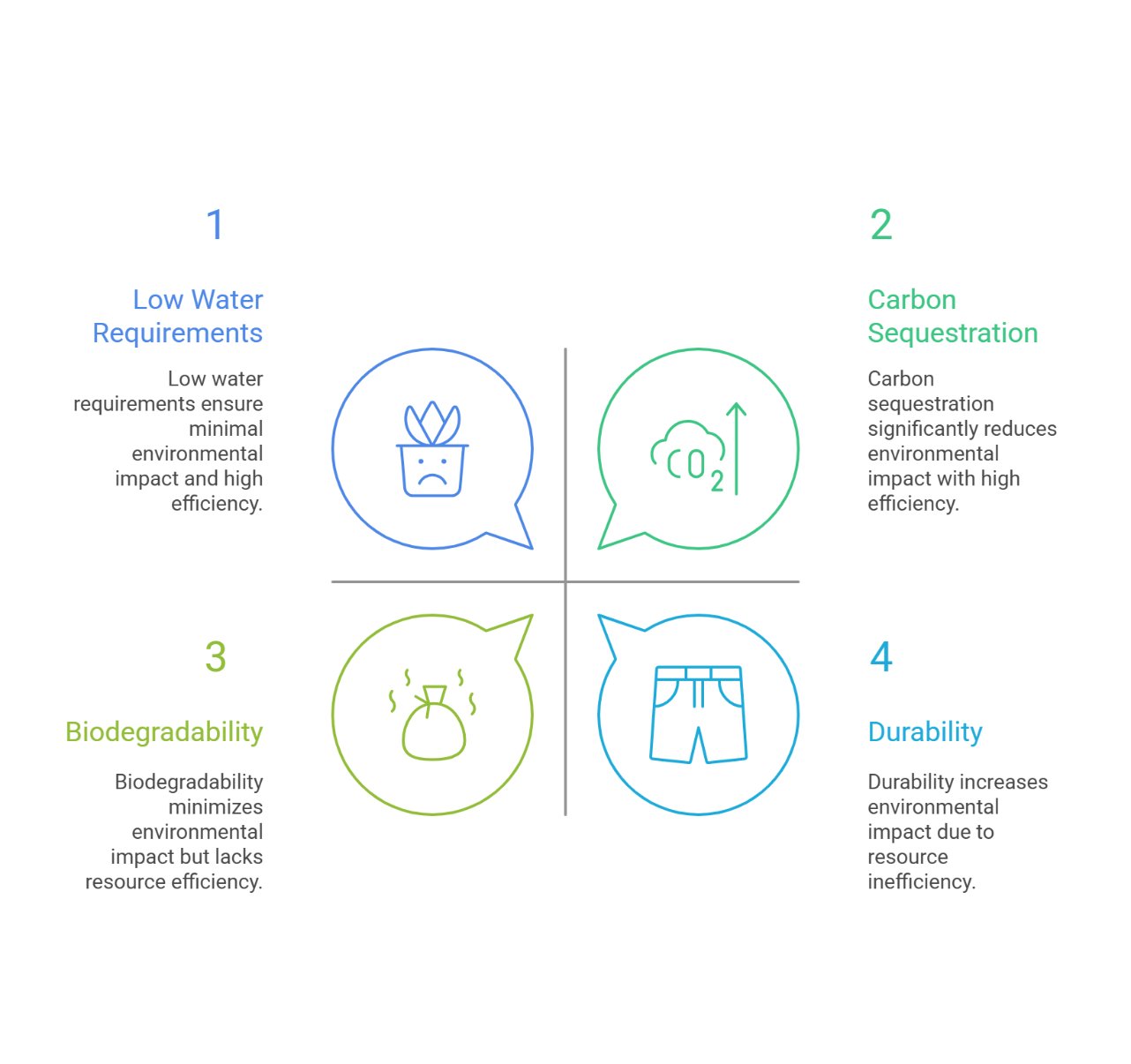
In 2025, sustainability is more important than ever, and linen stands out as one of the most environmentally friendly fabrics available.
Low Water Requirements
Flax plants require significantly less water than cotton. They typically grow on rainwater alone, without need for irrigation. This makes linen production much more sustainable in terms of water usage – about 80% of linen’s total energy consumption happens during its use phase (washing), not production.
Minimal Chemical Use
Flax grows well without pesticides, herbicides, or fertilizers. The plants are naturally pest-resistant and can even thrive in poor soil. After harvest, the roots left in the ground actually help fertilize and clean the soil for future crops.
Carbon Sequestration
Flax plants absorb carbon dioxide as they grow. Each hectare of flax retains about 3.7 tons of CO2 per year. This helps offset the carbon footprint of textile production.
Biodegradability
Unlike synthetic fabrics like polyester, linen is completely biodegradable. Untreated linen can start breaking down in soil within a few weeks, with complete decomposition happening in years rather than centuries. There’s no microplastic pollution.
Every Part is Usable
Nothing from the flax plant goes to waste. The fibers become linen fabric and thread. The seeds are pressed into linseed oil or ground into nutritious flaxseed meal. Shorter fibers can be used for paper or biomaterials. Even the woody parts have industrial uses.
Durability Means Less Waste
Because linen lasts so long, you don’t need to replace it as often. This reduces overall consumption and waste. A well-made linen garment can last 20-30 years or more with proper care.
2025 Sustainability Spotlight
Linen has been recognized as the most sustainable fabric of 2025. With growing awareness of fashion’s environmental impact, consumers are choosing linen for its low resource requirements, biodegradability, and longevity. Many sustainable fashion brands now prioritize linen in their collections.
How to Wash and Care for Linen
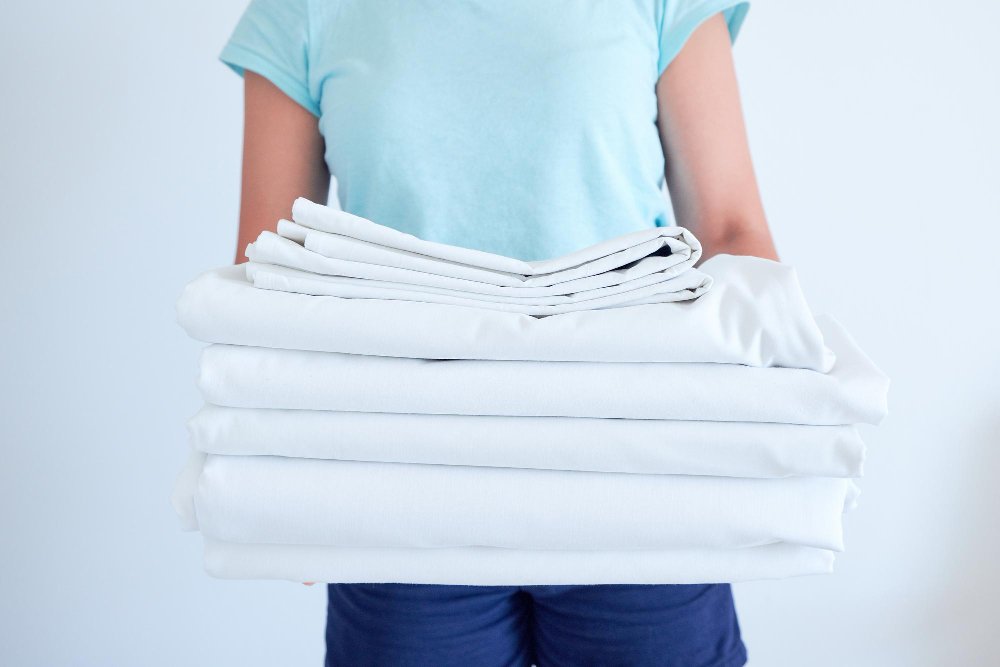
Caring for linen is easier than you might think. The fabric is actually quite forgiving, though following these guidelines will help it last longer and look better.
Get Personalized Care Instructions
Every linen item is different. Use our Linen Care Calculator to get customized washing, drying, and storage recommendations based on your specific linen type, color, and item.
Washing Linen
First Wash: Always wash new linen before using it. This removes any processing residues and starts the softening process. New linen can shrink 3-5% in the first wash, so pre-washing is important for garments.
Temperature: You can machine wash most linen in lukewarm or cold water (30-40°C/86-104°F). Hot water isn’t necessary since linen doesn’t trap dirt the way cotton does. For bed linens and towels, you can use 60°C (140°F) if needed for hygiene, but this may cause more shrinkage and fading over time.
Detergent: Use a mild, liquid detergent. Avoid bleach, which can weaken the fibers and cause yellowing. Never use fabric softener – it coats the fibers and reduces linen’s natural absorbency and softness development.
Machine Settings: Use a gentle cycle. Linen is strong, but gentler washing helps prevent excessive wrinkling. Let garments soak in water before washing to reduce folding damage.
Hand Washing: For delicate linen items, embroidered pieces, or sheer curtains, hand washing is safer. Use cool water and gentle agitation.
Does Linen Shrink When Washed?
Yes, linen can shrink, especially the first time it’s washed. Expect 3-5% shrinkage if the fabric hasn’t been pre-washed. Hot water and high dryer heat increase shrinkage. To minimize this, wash in cool or lukewarm water and air dry when possible. Many manufacturers now sell pre-washed linen that has already gone through its initial shrinkage.
Does Linen Shrink in the Dryer?
Yes, the dryer can cause linen to shrink, especially on high heat. If you do use a dryer, choose low heat and remove items while still slightly damp. However, air drying is always the best option for linen.
Drying Linen
Air Drying (Best Method): Hang linen to dry naturally. This prevents shrinkage and helps reduce wrinkles. Smooth the fabric by hand while damp to minimize creases. Line drying outdoors in fresh air is ideal.
Tumble Drying: If you must use a dryer, use low heat and remove items while still damp. Overdrying makes linen stiff and increases wrinkling. The slight dampness helps with ironing later.
Avoid Direct Sunlight: While linen can be dried outdoors, avoid leaving dyed linen in bright sunlight for extended periods as colors may fade.
Ironing Linen
Linen looks beautiful when ironed, but it’s not always necessary. The natural, slightly wrinkled look is part of linen’s charm and is perfectly acceptable for casual wear.
If you want to iron: Use high heat with steam for best results. Iron while the fabric is still slightly damp from washing, or use a spray bottle to dampen it. Iron on the wrong side to preserve the fabric’s natural luster on the front.
Steaming: A steamer works wonderfully on linen and is faster and gentler than ironing. It refreshes the fabric and removes light wrinkles without the risk of shine marks.
Why is Linen So Hard to Iron?
Linen wrinkles easily because its fibers lack elasticity. The fabric also has a tendency to develop new wrinkles even as you’re ironing others. The key is to iron while damp and use plenty of steam. However, many linen lovers simply accept the wrinkles as part of the fabric’s natural character.
Watch this helpful video guide on washing and drying linen without the need for ironing
Storing Linen
Store clean, dry linen in a cool, dry place with good air circulation. Avoid plastic bags, which can trap moisture. For long-term storage, use breathable cotton bags or wrap items in acid-free tissue paper. Linen is naturally moth-resistant, so you don’t need mothballs.
Quick Care Tips
Does linen get softer over time? Yes! This is one of linen’s best qualities. Each wash makes it softer and more comfortable. Well-worn linen has a luxurious, lived-in feel that new linen doesn’t have.
For step-by-step guidance tailored to your specific linen items, use our Linen Care Calculator for personalized washing and maintenance instructions.
Why is Linen So Expensive?
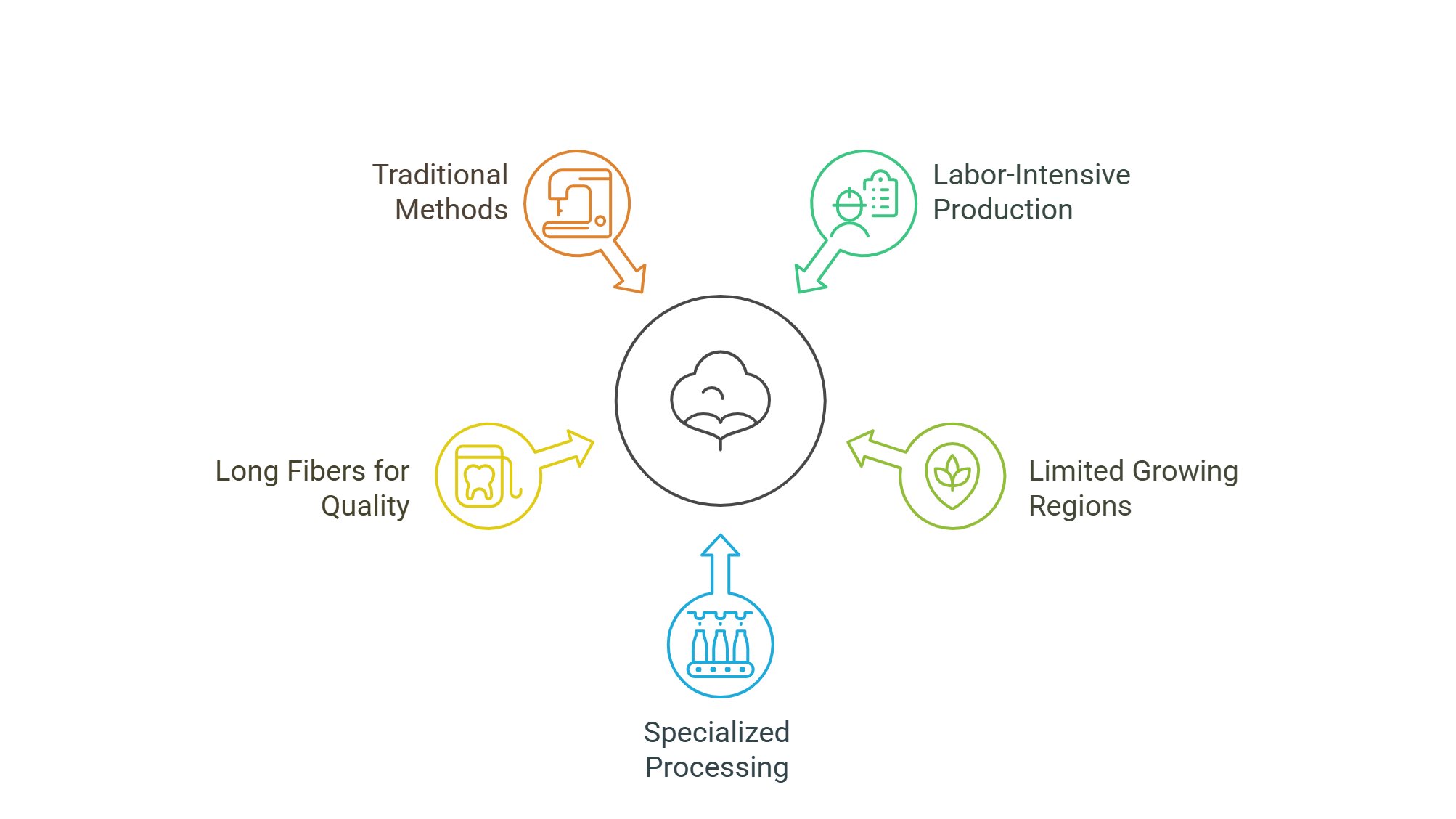
If you’ve shopped for linen, you’ve probably noticed it costs more than cotton or synthetic fabrics. There are several reasons for this price difference:
Labor-Intensive Production
Producing linen requires many steps, some of which are still done by hand or with specialized equipment. The retting process alone takes weeks. Separating the fibers from the woody parts of the flax stem requires skill and time.
Limited Growing Regions
Flax grows best in specific climates. The highest quality linen comes from Belgium and France, where cool, cloudy weather and specific soil conditions create ideal growing environments. This geographical limitation affects supply.
Specialized Processing
The equipment and expertise needed to process flax into linen are specialized. Not every textile mill can produce quality linen. European mills, particularly in Italy, are known for the best linen but command premium prices.
Long Fibers for Quality
The best linen uses long flax fibers, which must be carefully extracted and processed. Short fibers are cheaper to process but produce lower quality, coarser fabric.
Traditional Methods
Many producers maintain traditional production methods that prioritize quality over speed. This handcrafted approach increases costs but results in superior fabric.
Is Linen a Cheap Fabric?
No, linen is not a cheap fabric. It’s typically more expensive than cotton, though prices vary widely based on quality, origin, and whether it’s 100% linen or a blend. You can expect to pay $10-30 per yard for quality linen fabric, with premium varieties costing $40 or more per yard. Finished linen garments and bedding also command higher prices than their cotton equivalents.
Is Linen a Luxury Material?
Yes, linen is generally considered a luxury or premium fabric. Its higher cost, beautiful drape, natural elegance, and superior properties place it in the higher-end category. Throughout history, fine linen has been associated with quality and status. In ancient Egypt, it was used as currency among the wealthy.
The Value Proposition
While linen costs more upfront, consider the long-term value:
Durability: Linen lasts much longer than cheaper fabrics, often decades with proper care.
Timelessness: Linen’s classic appeal never goes out of style.
Improving with age: Unlike most fabrics that deteriorate, linen gets better over time.
Versatility: Quality linen works for multiple seasons and occasions.
When you calculate cost per wear over the lifetime of a linen item, it often ends up being more economical than cheaper alternatives that need frequent replacement.
Frequently Asked Questions About Linen
Yes, linen is excellent for skin. It’s naturally hypoallergenic and antibacterial, making it ideal for people with sensitive skin, allergies, or skin conditions like eczema. The fabric doesn’t irritate skin and actually has anti-inflammatory properties. Linen has been used in medical applications for thousands of years because of these qualities.
Yes, linen wrinkles very easily. This is because linen fibers have low elasticity and don’t bounce back from creasing like other fabrics. However, these natural wrinkles are considered part of linen’s charm and relaxed elegance. If you prefer a crisp look, you can iron or steam linen, but many people embrace the casual, lived-in appearance of wrinkled linen.
Linen is actually cooler than cotton in warm weather due to its superior breathability and moisture-wicking properties. However, medium and heavy-weight linen can provide warmth in cooler weather when layered properly. The hollow fibers act as insulators, trapping warm air. So linen can work in both hot and cold conditions, though it’s most famous for keeping you cool.
Not always. While some garments are made from 100% pure linen, many are blends. Common blends include linen-cotton, linen-viscose, and linen-polyester. Blends are often used to reduce cost, minimize wrinkling, or add specific properties like stretch. Always check the label to see the fiber content. If it says “linen” without specifying percentage, it should be at least 50% linen in most countries.
Yes, linen is considered a beautiful and desirable fabric. It has natural elegance with its subtle luster and organic texture. The fabric drapes beautifully and has a timeless appeal that works in both casual and formal settings. As it ages and softens, it becomes even more pleasant. Many people find the natural, slightly imperfect quality of linen more appealing than synthetic perfection.
Belgian and French linen are generally considered the highest quality, along with Irish linen for fine goods. European linen (particularly from Italy) is also excellent. The “best” type depends on your needs: Belgian linen is great for upholstery, Irish linen for fine table linens, and European linen for clothing. Look for linen made from long fibers with appropriate weight for your intended use.
Luxury hotels typically use high-quality European linen or linen blends for bedding and table linens. Many prefer Belgian linen or linen-cotton blends that combine durability with softness. Hotel linen is usually medium to heavy-weight (180-250 GSM) to withstand frequent washing while maintaining quality and comfort. Some hotels use 100% linen for luxury suites and linen-cotton blends for standard rooms.
No, linen and polyester are completely different. Linen is a natural fiber from plants, while polyester is a synthetic fiber made from petroleum. Linen breathes well, absorbs moisture, and biodegrades naturally. Polyester doesn’t breathe as well, can feel clammy when you sweat, and takes hundreds of years to break down. They look and feel very different too – linen has natural texture and wrinkles, while polyester is usually smooth and wrinkle-resistant.
People wear linen for its comfort, especially in warm weather. The fabric keeps you cool, wicks away moisture, and feels light against the skin. It’s also durable and long-lasting, making it a good investment. The natural, elegant look of linen works for both casual and dressy occasions. Plus, linen is environmentally friendly, which appeals to people concerned about sustainability.
Linen comes in many weights, from very thin to quite thick. Lightweight linen (90-170 GSM) is thin and perfect for summer clothing. Medium-weight linen (180-250 GSM) is moderately thick and used for most garments and bedding. Heavy-weight linen (260-420+ GSM) is thick and sturdy, ideal for upholstery and durable items. The weight you need depends on what you’re making or buying.
Linen is a natural fabric made from a natural plant – the flax plant. While the process of turning flax into linen fabric involves human manufacturing steps, the raw material itself is completely natural. This makes linen different from synthetic fabrics like polyester, which are made from petroleum-based chemicals. Linen is biodegradable and eco-friendly.
Linen is neither silk nor synthetic. It’s a natural plant-based fiber from flax stems. Silk is also natural but comes from silkworm cocoons (animal-based). Synthetic fabrics like polyester are made from chemicals. Linen, cotton, and hemp are plant fibers. Silk and wool are animal fibers. Polyester, nylon, and acrylic are synthetic. Each has different properties and uses.
Yes, linen can definitely be thick. Heavy-weight linen used for upholstery can be 260-420+ GSM (grams per square meter) or even heavier. This thick linen is incredibly durable and suitable for furniture that gets daily use. Belgian linen is known for being particularly heavy and robust, making it ideal for sofas, chairs, and other items that need to withstand wear and tear.
Conclusion
After exploring everything about linen fabric, it’s clear why this ancient textile has remained popular for over 30,000 years. Linen offers a unique combination of strength, breathability, and natural beauty that few other fabrics can match.
The fabric’s connection to sustainability makes it particularly relevant today. As consumers become more aware of environmental issues, linen stands out as a responsible choice. It requires minimal water and chemicals to grow, biodegrades naturally, and lasts for decades with proper care. Every part of the flax plant can be used, creating zero waste in production.
While linen has some drawbacks – it wrinkles easily, costs more than cotton, and can shrink if not cared for properly – these are minor compared to its many benefits. The wrinkles give it character and a relaxed elegance. The higher price reflects quality craftsmanship and long-term value. The initial stiffness gives way to incredible softness with each wash.
Key Takeaways
For clothing: Choose lightweight to medium-weight linen (90-190 GSM) for summer garments. Look for long-fiber linen for smoother, more durable fabric.
For bedding: Medium-weight linen (180-220 GSM) works best for sheets and pillowcases. Pre-washed linen avoids shrinkage issues.
For upholstery: Heavy-weight Belgian or European linen (280+ GSM) provides durability for furniture and high-traffic items.
For care: Wash in lukewarm water, skip the fabric softener, air dry when possible, and embrace the natural wrinkles. Your linen will get softer and more beautiful with each wash.
For sustainability: Choose 100% linen from European sources when possible. The investment in quality linen pays off both environmentally and financially over the fabric’s long lifetime.
Whether you’re making summer clothing, investing in luxury bedding, or choosing sustainable fabrics for your home, linen offers timeless appeal and practical benefits. Its natural cooling properties make it perfect for hot weather, while its insulating qualities work for cooler months when layered. The fabric’s antibacterial and hypoallergenic properties benefit sensitive skin, and its strength means items can last for generations.
In 2025 and beyond, as fashion and home decor trends continue emphasizing natural materials and sustainable choices, linen is positioned to remain at the forefront. Its minimalist aesthetic fits perfectly with contemporary design while maintaining classic elegance that never goes out of style.
The beauty of linen lies not just in how it looks when new, but in how it ages. Unlike most fabrics that deteriorate over time, linen gets better. It softens, develops character, and becomes more comfortable with every use. This quality of improving with age makes linen not just a purchase, but an investment in long-term comfort and sustainability.
If you’re ready to explore more natural fabrics, consider learning about cotton, silk, or wool. Each has unique properties that make it suitable for different applications. For more sewing and fabric care tips, check out our beginner’s guide to sewing and learn proper fabric care techniques.

